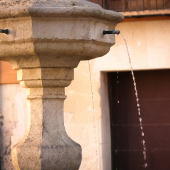The city of the Borgias
The rich legacy of a Renaissance family
The city of the Borgias
The rich legacy of a Renaissance family
CALLIXTUS III and ALEXANDER VI
Xàtiva can boast of being the birthplace of the Borgias, one of the most powerful families of the Renaissance. The family attained universal fame with two popes, Alfons de Borja (Callixtus III, 1456–1458), and his nephew Roderic de Borja (Alexander VI, 1492–1503). The Borgias occupied many positions of civil and ecclesiastical power, as did Saint Francis Borgia subsequently, who became third general of the Society of Jesus (1565–1572). The family’s evil fame, to some extent deserved, has been magnified by portrayals in film and literature. Their reputation had its origins in the nepotism of the two popes and the intrigues of Alexander VI and his children, Giovanni, Cesare, Lucrezia and Goffredo, but should be placed its historical context.
One of the most fascinating ways to see Xàtiva is to follow the Borgia route, which takes in the buildings and places that were related to this notorious family. Winding through the old quarter, the route leads us in the footsteps of two popes and other prominent members of the House of Borgia.
Iglesia de Sant Francesc church
In the late 14th century, the Borgias had a funeral chapel in this church, which due to its location in the aristocratic area made it the last resting place of choice for some of the nobility. Catalina de Borja, sister of Callixtus III, the grandparents of Pope Alexander VI and other relatives were all buried here. In 1470, their remains were moved to the collegiate church.
Iglesia de Sant Francesc church
In the late 14th century, the Borgias had a funeral chapel in this church, which due to its location in the aristocratic area made it the last resting place of choice for some of the nobility. Catalina de Borja, sister of Callixtus III, the grandparents of Pope Alexander VI and other relatives were all buried here. In 1470, their remains were moved to the collegiate church.
Carrer Montcada street
This most majestic and historically important of streets is lined with urban palaces, the residences of the local nobility and several convents. All the leading noble families built their homes here, as did the Duke of Gandia, where it is said that Pere Lluís Galcerà Borja, brother of Saint Francis Borgia and last Grand Master of the Order of Montesa, once lived.
Carrer Montcada street
This most majestic and historically important of streets is lined with urban palaces, the residences of the local nobility and several convents. All the leading noble families built their homes here, as did the Duke of Gandia, where it is said that Pere Lluís Galcerà Borja, brother of Saint Francis Borgia and last Grand Master of the Order of Montesa, once lived.
Real Monasterio de Santa Clara monastery
Founded in the 1325 by Doña Saurina de Entença, the widow of Roger de Lauria, the monastery was constructed in the Gothic-Mudéjar style. It was the richest and most lavish monastery in the city, and for a time its abbess was Beatriz de Borja. Renovated in the 17th and 18th centuries, the mediaeval refectory and dormitory have been preserved to the present day.
Real Monasterio de Santa Clara monastery
Founded in the 1325 by Doña Saurina de Entença, the widow of Roger de Lauria, the monastery was constructed in the Gothic-Mudéjar style. It was the richest and most lavish monastery in the city, and for a time its abbess was Beatriz de Borja. Renovated in the 17th and 18th centuries, the mediaeval refectory and dormitory have been preserved to the present day.
Fuente de la Trinitat fountain
When this was built in the last third of the 15th century, Callixtus III was still only a boy. It is one of the few Gothic fountains to have been preserved in Spain. The originally polychrome octagonal basin shows the city’s coats of arms and those of the Kingdom in alternation. The square also houses the only surviving vestige of the former Trinitarios convent, a magnificent doorway.
Fuente de la Trinitat fountain
When this was built in the last third of the 15th century, Callixtus III was still only a boy. It is one of the few Gothic fountains to have been preserved in Spain. The originally polychrome octagonal basin shows the city’s coats of arms and those of the Kingdom in alternation. The square also houses the only surviving vestige of the former Trinitarios convent, a magnificent doorway.
Birthplace of Pope Alexander VI
The Plaza de Alejandro VI square, named after the mediaeval Borgias, is home to the house where this famous family resided from as early as 1378. It was here that Roderic de Borja, the future Pope Alexander VI, was born, as commemorated by a plaque. The house remained in the family for generations. It was restored in the mid-15th century.
Birthplace of Pope Alexander VI
The Plaza de Alejandro VI square, named after the mediaeval Borgias, is home to the house where this famous family resided from as early as 1378. It was here that Roderic de Borja, the future Pope Alexander VI, was born, as commemorated by a plaque. The house remained in the family for generations. It was restored in the mid-15th century.
Iglesia de Sant Pere church
This was built in the Isabelline Gothic style in the mid-15th century. Roderic de Borja, the future Pope Alexander VI, was baptised in the church in 1432. It consists of a single nave with three diaphragm arches and a Mudéjar coffered ceiling. At the end of the 17th century, it underwent a Baroque reform.
Iglesia de Sant Pere church
This was built in the Isabelline Gothic style in the mid-15th century. Roderic de Borja, the future Pope Alexander VI, was baptised in the church in 1432. It consists of a single nave with three diaphragm arches and a Mudéjar coffered ceiling. At the end of the 17th century, it underwent a Baroque reform.
Casa Artigues tiled memorial
This tiled memorial in Rococo style was the result of a popular initiative in the 18th century. It depicts real and imaginary sons of Xàtiva, above all religious ones such as the two popes, Callixtus III and Alexander VI, and adorns the façade of the Casa Artigues, home of a prominent local family of pharmacists.
Casa Artigues tiled memorial
This tiled memorial in Rococo style was the result of a popular initiative in the 18th century. It depicts real and imaginary sons of Xàtiva, above all religious ones such as the two popes, Callixtus III and Alexander VI, and adorns the façade of the Casa Artigues, home of a prominent local family of pharmacists.
The Colegiata
Bronze sculptures of the two Borgia popes, made by Octavio Vicent, flank the entrance in the main façade. Pope Callixtus III, who ordered the construction of the subsequently demolished Borgia chapel, was baptised here. The collegiate museum collection contains numerous pieces related to the Borgias, such as the Retablo de Santa Ana altarpiece, also known as the Callixtus III altarpiece, Callixtus III’s chalice and Alexander VI’s Custodia Mayor del Corpus.
The Colegiata
Bronze sculptures of the two Borgia popes, made by Octavio Vicent, flank the entrance in the main façade. Pope Callixtus III, who ordered the construction of the subsequently demolished Borgia chapel, was baptised here. The collegiate museum collection contains numerous pieces related to the Borgias, such as the Retablo de Santa Ana altarpiece, also known as the Callixtus III altarpiece, Callixtus III’s chalice and Alexander VI’s Custodia Mayor del Corpus.
El Palau palace
Built in the 15th century, this was the seat of the archdeacon of the collegiate church, a title always bestowed on a canon of the Cathedral of Valencia. The noble keystone door is surmounted by the coat of arms of Callixtus III and two others of the Borgia-Oms branch of the family, which might belong to Roderic or Cesare Borgia, archbishops of Valencia.
El Palau palace
Built in the 15th century, this was the seat of the archdeacon of the collegiate church, a title always bestowed on a canon of the Cathedral of Valencia. The noble keystone door is surmounted by the coat of arms of Callixtus III and two others of the Borgia-Oms branch of the family, which might belong to Roderic or Cesare Borgia, archbishops of Valencia.
Museum of Fine Arts
The chapel that Pope Callixtus III ordered to be built in the Seu endowed Xàtiva with a notable flamboyant Gothic heritage. However, centuries later, the chapel was demolished. The only surviving vestiges of its past existence are the beautiful remains preserved in the museum, including the vault keystone and the angel corbel that supported this prominent family’s coat of arms.
Museum of Fine Arts
The chapel that Pope Callixtus III ordered to be built in the Seu endowed Xàtiva with a notable flamboyant Gothic heritage. However, centuries later, the chapel was demolished. The only surviving vestiges of its past existence are the beautiful remains preserved in the museum, including the vault keystone and the angel corbel that supported this prominent family’s coat of arms.
El castell
The fortress was used as a State prison by the ancient Crown of Aragon. In the 16th century, Saint Francis Borgia’s brother, Diego de Borja, was imprisoned and subsequently executed here, accused of a murder perpetrated in an outbreak of rivalry among the noble factions of the time.
El castell
The fortress was used as a State prison by the ancient Crown of Aragon. In the 16th century, Saint Francis Borgia’s brother, Diego de Borja, was imprisoned and subsequently executed here, accused of a murder perpetrated in an outbreak of rivalry among the noble factions of the time.
AUDIO GUIDES

THE BORGIA ROUTE
This route leads visitors around the main monuments associated with the Borgia family.
“Nós mirem amb singular dilecció la ciutat i el seu país d’on som natural i que portem en les entranyes i desitgem amb el més sincer afecte el seu honor i prestigi.”
“We look with singular favour on our native city and country, which we carry in our hearts and whose honour and prestige we desire with the most sincere affection.“
Alejandro VI
Responsible for the Papal Bull “Inter caetera”
(Xàtiva 1431 / Roma 1503)






